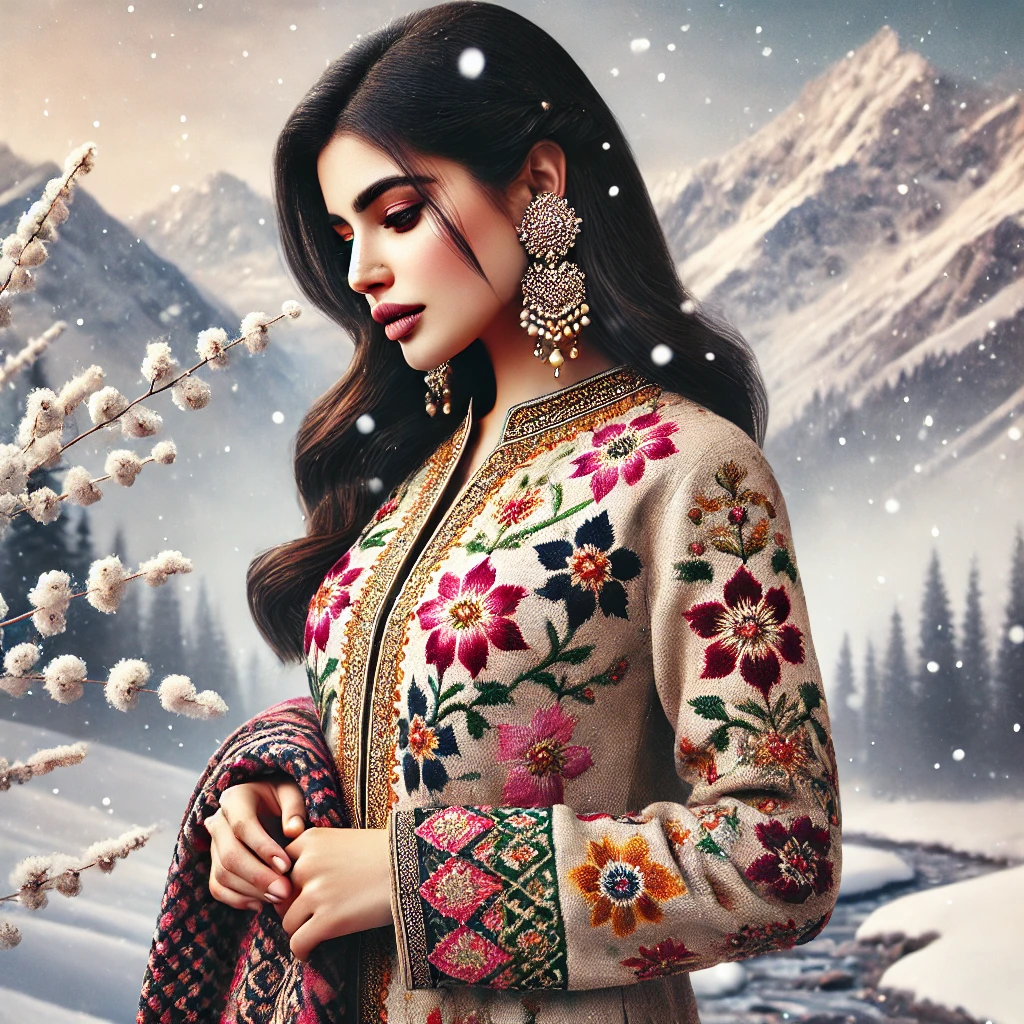Kashmiri fashion is a breathtaking blend of tradition, craftsmanship, and cultural heritage. Nestled in the lap of the Himalayas, Kashmir has a rich sartorial history that reflects its diverse influences, from Persian and Central Asian styles to Mughal-era grandeur. The traditional attire of Kashmiris is not just a mark of identity but also a testament to their resilience against the harsh winters and the region’s deeply ingrained aesthetic sensibilities.
The Traditional Attire of Kashmir

1. Pheran – The Quintessential Kashmiri Dress
One of the most iconic garments of Kashmiri fashion is the Pheran. A traditional, loose-fitting, long robe worn by both men and women, designed to keep them warm during the cold winter months. It is a staple of Kashmiri clothing that is known for its comfort, warmth and aesthetic appeal. Women’s Pherans are often embroidered with intricate Tilla work, a gold or silver thread embroidery that adds a regal touch to the attire. Men’s Pherans are usually simpler, made of thick wool and designed for functionality.
2. Taranga – The Traditional Headgear
For Kashmiri women, the Taranga is an essential part of bridal wear. It is a long, elaborate headdress worn over the head and extends down the back, symbolizing marital status and Kashmiri customs & is a brightly colored scarf or Taranga. The vibrant colors and intricate embroidery make it a standout feature of Kashmiri attire.
3. Pashmina Shawls – The Ultimate Luxury
A pashmina shawl is one such basic accessory that may make your ensemble look better. Kashmir is world-renowned for its Pashmina shawls, which are crafted from the fine wool of the Changthangi goat found in the high-altitude regions of Ladakh. These shawls are handwoven and often feature exquisite Kashmiri embroidery such as Sozni (needle embroidery) and Jamawar (brocade weaving). Owning a Pashmina shawl is considered a mark of luxury and elegance.
4. Kashmiri Sarees – A Blend of Tradition and Modernity
While sarees are not traditionally Kashmiri, contemporary Kashmiri designers have incorporated Kashmiri embroidery and motifs into sarees, creating stunning fusion wear. These sarees are often adorned with Sozni embroidery or Tilla work, making them a unique blend of Kashmiri tradition and pan-Indian draping styles.
5. Pathani Suits and Embroidered Kurtas for Men
Kashmiri men often wear Pathani suits, which consist of a long tunic and loose trousers, a style influenced by Central Asia. Many also prefer embroidered woolen kurtas paired with Kashmiri shawls, adding an element of sophistication to their winter wardrobe.
Read About: 10 Indian Fashion Trends for Winter: Stay Stylish in the Cold
Exquisite Embroidery Styles of Kashmir
The charm of Kashmiri fashion lies not just in the silhouettes of its garments but also in the intricate hand-embroidery that adorns them. Some of the most celebrated embroidery styles include:
1. Sozni Embroidery
Sozni, or needlework embroidery, is a fine and delicate art where floral and paisley motifs are stitched onto Pashmina shawls, woolens and even sarees. It is a time-intensive process, often taking months to complete a single piece.
2. Tilla Work
Tilla embroidery is done using gold and silver threads on Pherans, shawls, and other traditional wear, giving them a royal appeal. This form of embroidery is particularly popular for bridal and festive attire.
3. Aari Work
Aari embroidery is created using a special hooked needle, producing fine chain stitch patterns on woolen and silk fabrics. This type of embroidery is often seen on Kashmiri kurtas, dupattas, and shawls.
4. Papier-mâché Embroidery
Inspired by Kashmiri papier-mâché art, this embroidery style incorporates vibrant and intricate floral patterns onto fabrics, creating a unique and colorful aesthetic.
Traditional Kashmiri Jewelry
Jewelry plays a crucial role in Kashmiri fashion, adding a touch of elegance and tradition to the attire. Some of the most popular Kashmiri jewelry pieces include:
- Dejhoor: Long gold earrings worn by married Kashmiri Pandit women, symbolizing marital status.
- Nau Nari Haar: A traditional necklace made of gold and precious stones, often worn by brides.
- Tika: A forehead ornament that adds a regal touch to festive attire.
- Silver and Gold Bangles: Intricately designed bangles that enhance the beauty of traditional Kashmiri wear.
Modern Influence and Contemporary Kashmiri Fashion
While traditional Kashmiri fashion remains timeless, contemporary designers are reinventing these styles for modern tastes. Fusion wear, such as pairing a Pashmina stole with Western outfits or styling an embroidered Kashmiri kurta with jeans, has gained popularity among younger generations.
Several Kashmiri designers are now blending heritage crafts with contemporary silhouettes, creating unique ensembles that appeal to both Indian and global audiences. Fashion weeks and runways often feature Kashmiri-inspired designs, showcasing the region’s rich textile heritage.
The Global Appeal of Kashmiri Fashion
Kashmiri fashion has transcended regional boundaries, making its mark on international fashion platforms. Celebrities and designers worldwide appreciate and incorporate Kashmiri embroidery, fabrics, and motifs into their collections. Pashmina shawls are considered a luxury item globally, and Kashmiri embroidery is often seen in haute couture collections.
Preserving Kashmiri Craftsmanship
Traditional Kashmiri fashion is loved around the world, but it’s at risk. Many skilled craftspeople who create these beautiful textiles are leaving the trade, while cheap machine-made copies flood the market. To keep this centuries-old art form alive, we need to support the local artisans who make authentic Kashmiri textiles by hand. Some efforts are already underway – like special labels that guarantee genuine Pashmina shawls and government programs to help craftspeople – but more needs to be done to protect this precious part of Kashmir’s culture.

